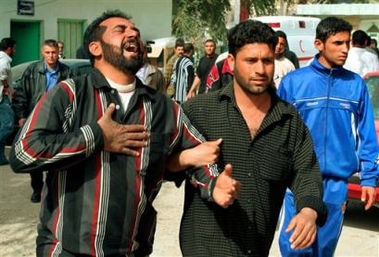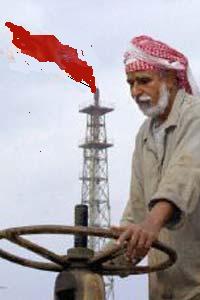80 Bodies Found
Massive Attack on Green Zone Foiled
Al-Hayat reports fighting in Ramadi between guerrillas and US forces. I guess that isn’t news anymore, since I didn’t see it elsewhere.
Some 80 bodies have been found in Baghdad and environs since Monday. On Tuesday alone, police discovered 46 bodies around the capital. They appear mostly to have been Sunni Arabs targeted by enraged Shiites attacked by the guerrillas during the past three weeks. Some were in the back of a minibus. Some were in a mass grave in Shiite East Baghdad. The latter were discovered when passers-by saw blood oozing out of the earth. Blood oozing out of the earth is a good metaphor for Iraq nowadays. As one of my readers noted, if the US military isn’t in Iraq to prevent a civil war, then they must be there to guard the oil. I feel an editorial photo-cartoon coming on.
Although young Shiite cleric Muqtada al-Sadr has called for peace and lack of reprisals, clearly a lot of furious Shiites are paying no attention to him. When people are really angry, the clerics lose a lot of their influence. If people in Lebanon had listened to their clerics, there never would have been a civil war there. At some point, political resentments go so far that the sermons themselves become helpless.
US ambassador Zalmay Khalilzad attended a meeting with top Iraqi politicians to try to break the deadlock on forming a government.
Minister of Interior Bayan Jabr announced that a plot had been foiled to place hundreds of Sunni Arab troops actually loyal to the insurgency in position at the Green Zone and then to have them rush embassy offices and take diplomatic hostages. The Green Zone is a barricaded area of downtown Baghdad. There have been rumors for weeks that the Sunni Arab guerrillas were preparing to “rise up” and take the capital. This was probably the plan to which the rumor mongers were referring. Or, a more frightening thought: the rumors refer to yet another plot. Anyway, apparently the US and the new government barely dodged this bullet. It would have been horrible. But you do have the sense that with the siege of Baghdad going on, the Green Zone is becoming vulnerable and could ultimately fall.
Al-Zaman says that the Shiite religious coalition, the United Iraqi Alliance, has rejected a system of cabinet rule, wherein the prime minister would have to take issues to his cabinet for a vote. From a Shiite point of view, the US and other Iraqi factions are trying to find ways of robbing it of its electoral victory on Dec. 15.
Al-Zaman reports that in the end, the politicians decided to deal with the paralysis by . . . appointing a committee. Oh, yeah. That will move things along.
Victims of Hurricane Katrina and Veterans are staging a peace march to New Orleans, ending on Saturday. They are demanding an end to the Iraq War and a big increase in funding to help those hundreds of thousands of Americans hurt by the hurricane and the Bush administration’s wholly inadequate response to it.
Gen. Peter Pace acted bravely and honestly on Tuesday by contradicting Bush’s Monday claims that the Iranian government was supplying bombs to the guerrilla insurgency in Iraq. Pace admitted he had no evidence that the Iranian state was doing any such thing. (Of course it is not.)
[Ar.]Iraq Prime Minister Ibrahim Jaafari denied on Tuesday US charges that there were Iranian Revolutionary Guards on Iraqi soil. Jaafari is right. If there were many revolutionary guards in Iraq, they would be being captured in some numbers by US troops in their sweeps. No such thing has happened. The Bush administration has to make up its mind as to whether Jaafari’s election is a great good thing and a model of democracy for the region, or it is an unwelcome sign of Iranian influence in Iraq. You can’t have it both ways.
My article, Fishing for a Pretext in Iran, is out at Truthdig.com. Excerpt:
If the Supreme Jurisprudent of theocratic Iran has given a fatwa against nukes, if the president of the country has renounced them and called for others to do so, if the International Atomic Energy Agency has found no evidence of a military nuclear weapons program, and if Iran is at least 10 years from having a bomb even if it is trying to get one, then why is there a diplomatic crisis around this issue between the United States and Iran in 2006?
The trolls are out amid some otherwise insightful discussions of the piece, both at the truthdig site and at Daily Kos, where Steven D. kindly put up a diary on the piece. Some liar attempted to cast aspersions on my Arabic, which I speak with near-native fluency (and why would it matter for this article–isn’t my Persian the relevant question there? Maybe the idiot who smeared me thinks Iranians are Arabs or something.) Then there were snarky comments about my treatment of the Neocons in the article; one problem: I don’t mention any Neocons. Then someone alleged that Misbah-Yazdi gave a fatwa permitting nukes, contradicting Supreme Jurisprudent Ali Khamenei. The problem: Khamenei is the Supreme Jurisprudent and commander in chief of the armed forces, so it doesn’t matter if some ayatollah contradicts him. He makes the calls. Etc., etc. Tiresome and predictable attempts to muddy the waters.
By the way, check out the Iran Freedom Concert and the Iranian students’ petition against human rights abuses in the Islamic Republic and repression of the student movement.
Tom Lasseter of Knight Ridder traces the increased US bombing of Iraq, especially of the Sunni Arab areas. He writes that bombing raids are up 50 percent in 5 months and that 18 cities have been struck this year:
A review of military data shows that daily bombing runs and jet-missile launches have increased by more than 50 percent in the past five months, compared with the same period last year. . . The numbers also show that U.S. forces dropped bombs on more cities during the last five months than they did during the same period a year ago. Air strikes a year ago struck at least nine cities, but were mostly concentrated in and around the western city of Fallujah. This year, U.S. warplanes have struck at least 18 cities.
One of the many drawbacks of contemporary warfare is that we almost never get any actual images of these bombings. I have seen some footage on Aljazeera, but not on US channels. I remember seeing a community center near Karabila taken out altogether. It was obviously the nicest biggest building in the town. I couldn’t imagine that bombing made any friends for the US.
Al-Sharq al-Awsat reports that Ayatollah Husain Ismail al-Sadr, a relatively liberal Shiite cleric, is hosting a conference of Sunni, Shiite, Arab, Kurdish and other clerics in Kadhimiyah, which aims at issuing a joint fatwa or legal ruling that inter-sectarian killings are religiously forbidden.
Nearly 200 Iraqi academics have been assassinated during the past 3 years, raising fears of the emigration of large numbers of needed white collar professionals.
Sectarian rivalries and tensions have invaded campus life in Iraq. Universities were once centers of secular Arab and Iraqi nationalism.
Iraq’s electricity production has fallen to a 3-year low, in large part because of a successful guerrilla tactic of sabotage. They are besieging Baghdad with regard to fuel and electricity, demoralizing the most politically central portion of the population– the 6 million inhabitants of the capital, a fourth of the country. The Bush administration may need Iran’s help to bail them out this summer . . .
The Future of Iraq Project of the State Department, run by Tom Warrick for 2 years before the invasion, is now up on the Web. Donald Rumsfeld, Paul Wolfowitz and Douglas Feith tossed it in the trash can because they saw it as a blueprint for the US running Iraq for a while. They, in contrast, wanted just to turn Iraq immediately over to Ahmad Chalabi, whom they flew to the country in US military planes with 570 (unfortunately unarmed) Gucci revolutionaries.
The Future of Iraq suggested it might be necessary to take concrete steps to restore security and prosperity to Iraq. How much better was the Rumsfeld Plan– imperial puppetry and chaos.





 © 2025 All Rights Reserved
© 2025 All Rights Reserved